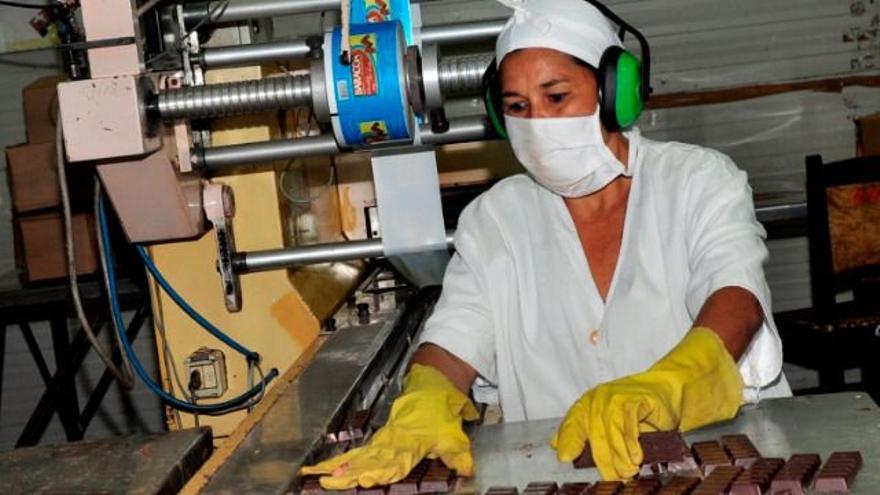
![]() 14ymedio, Havana, 14 August 2023 — The Baracoa cocoa factory begins production five years after the announcement of a million-dollar investment of unknown amount. The official press puts the amount at “43,000,000 between national and foreign currency,” which in practice means not revealing the amount. Of that money, “it owes thousands in MLC to the Empresa Forestal y del Coco de Baracoa, but the authorities already dream – as Granma headlines – of “getting revenue from the delicacy,” outside the Island, of course.
14ymedio, Havana, 14 August 2023 — The Baracoa cocoa factory begins production five years after the announcement of a million-dollar investment of unknown amount. The official press puts the amount at “43,000,000 between national and foreign currency,” which in practice means not revealing the amount. Of that money, “it owes thousands in MLC to the Empresa Forestal y del Coco de Baracoa, but the authorities already dream – as Granma headlines – of “getting revenue from the delicacy,” outside the Island, of course.
The official media dedicates a report to the factory, installed in the same space where it was inaugurated by then-Minister of Industry, Ernesto Che Guevara, in 1963. Two industrial processing lines will improve the product, making it profitable, and it will be “shipped abroad at excellent prices,” says Reynaldo Mosqueda Martínez, an engineer and investor. According to his account, two containers of cocoa butter and another two containers of micro-pulverized cocoa are currently being prepared for export.
Delay, as usual, has been the tendency since the reconversion of the factory was triumphantly announced in 2017. Those responsibile in this case are “the foreign manufacturers from whom the technology was purchased,” the Swiss Bühler and the Italian Mazzetti, who delayed sending technicians to train the Cubans, assemble and test the equipment, according to Granma.
In November 2021, the local press took up the issue again and stated that the pandemic had forced the delay in implementing the start-up of the plant, especially since national workers had to return to their provinces of origin and foreigners to their countries. That stopped the assembly of the machinery and all the subsequent phases, but the confidence was finally enough to begin, coinciding with the reopening of borders (on the 15th of that month and year).
As expected, the wait was prolonged, and only in November 2022 was the new industrial cocoa processing line launched, while the other line, responsible for the production of bon bons and bars, has been in testing since April and awaits a technical validation that has not yet happened.
Granma lyrically describes the operation of the “new” machine, which had its first effect on employment. The old one needed two workers, while the new needs only one. “We had to relocate forces to other areas,” says Juan Miguel Martínez, the brigade chief.
With the new technology, the cocoa bean is peeled, ground, pulverized, separated from the butter and packaged. The raw material is also dried, toasted and rid of bacteria. There is a new laboratory that makes sure that international standards are followed, and other areas have also been improved, from administrative to logistics and transport. “In the control room there is silence, just a computer and a girl with her hand on the mouse and her eyes fixed on the desk; Yisel Ochoa Llorente does not write, she clicks,” says the official newspaper, extolling the modernity of a computer rather than pencil and paper in the middle of 2023.
But where technology really makes a leap is in the quantities to be produced, as long as the forecasts are met. Mosqueda Martínez claims that before, seven tons of cocoa were processed in 16 hours. “With these teams we do twice that volume in the same amount of time.” The powdered cocoa bagging machine also doubles the speed: 42 seconds to fill a 33-pound bag. In 16 hours, the factory produced 2.5 tons of bars and jams that will now increase to 9.6. And the chocolates, he says, will also increase the revenue, because since April, bitter chocolate paste is being sold to the factories of Ciego de Ávila, Camagüey, Baracoa, Santiago de Cuba and Granma.
The new air conditioning to preserve the product also sounds promising. “Everything before ended in the same place: the cakes came out of the press burning hot and were stored here. We had to subject them to a cooling process that sometimes forced us to wait 24 hours to begin micropulverization. The most we achieved was a hundred sacks in one day. Now we can double that; the change has been like from night to day,” Martínez adds.
In addition, the product is “more refined, with a better finish, superior in terms of taste, smell and texture; in short, more competitive.”
However, the new industry suffers an evil that the old one never stopped suffering as well. “The tablet wrapping machine faces difficulties in synchronizing, and we need foreign technicians to make the readjustment. They are expected to arrive in the coming days, the director of the UEB, Pedro Azahares Cuza, confirmed to Granma. (…) Wish us luck.”
Translated by Regina Anavy
____________
COLLABORATE WITH OUR WORK: The 14ymedio team is committed to practicing serious journalism that reflects Cuba’s reality in all its depth. Thank you for joining us on this long journey. We invite you to continue supporting us by becoming a member of 14ymedio now. Together we can continue transforming journalism in Cuba.
